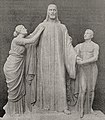Gustav Rutz

Karl Gustav Rutz (14 December 1857 – 9 August 1949)[1] was a German sculptor.
Life and work[]
Born in Cologne, Rutz was first a painting student of Julius Geertz in Düsseldorf. With his fellow students from the Geertz studio, and August Flinker, Gustav Rutz undertook study trips within Germany. In Munich he then trained in sculpture under . From 1879, Rutz settled in Düsseldorf.[2] His studio was located in 1888 directly opposite the south side of the in the house Hafenwall 7 (today Eiskellerstraße).[3] He became known for cemetery and monument sculptures as well as numerous fountains in German cities.[4] His sculptures, partly in the neobaroque style, earned nationwide fame at the time. Around 1899 he was a member of the .[5]
Beim Besuch des Kaiserpaares Wilhelm II. und Viktoria Ende Oktober 1900 in (Wuppertal-) wurde dort der „Siegesbrunnen mit Germania“ feierlich enthüllt. Wilhelm II. lobte Rutz als dessen Schöpfer, und am 27. Januar 1901, an des Kaisers Geburtstag, wurde der Siegesbrunnen ins Eigentum der Stadt Vohwinkel übernommen.[6]
In 1902, Rutz was awarded 1st prize in the competition for a Kaiser-Friedrich statue in Mönchengladbach, and was entrusted with its realisation. The statue was to be placed in the vestibule of the new city hall, the , which was inaugurated in 1903..[7]
Rutz was a member of the Malkasten. The Goethe-Herme made of stone was created by him on the occasion of the Düsseldorf Goethe Festival of 1899 and erected in 1903 in the Malkastenpark, the former "Jacobigarten".[8]
The architect built a two-storey villa for Gustav Rutz on the plot in Düsseldorf-Düsseltal in 1905-1906.
Rutz died at the age of 91 in the senior citizens' residence of the .
Work[]
- Graves in the : Family Hermes,[9] , Family Schlote, Family Schütte.[10]
- 1892: Gravesite of the piano maker Family at the in (Wuppertal-) Barmen.
- 1897: Standbild Kaiser Wilhelms I. in Burgsteinfurt, Markt (Melted down as a metal donation in 1942).[11]
- 1895–1896: Düsselnixe-Brunnen im Malkastenpark in Düsseldorf (Donated to the Artists' Association founded in 1848 for the upcoming 50th anniversary and erected in the park in 1897)
- 1899: Hohenzollernbrunnen in Rheydt, Marktplatz.[12] (The fountain was already quietly dismantled after World War I.)[13]
- 1899: Kaiser-Friedrich-Brunnen in Krefeld-Uerdingen, Marktplatz (1938/1939 demolished during the construction of a deep bunker under the square).[14]
- 1900: Victory Fountain with Germania figure in front of the former district hall in (Wuppertal-) , Gräfrather Straße (destroyed in World War II).[15]
- 1900: Kaiser Wilhelm I statue in Montabaur (dismantled and melted down in 1944)
- 1903: Monument to Count Arnold III, Count of Bentheim-Steinfurt-Tecklenburg-Limburg in .
- 1903/1904: Fountain figure "Wasserträgerin" (Water Bearer) in bronze for the grotto by the garden architect Martin Reinhardt (1876-1935) at the in Düsseldorf.[16]
- 1904: Bronze plaque of the psychiatrist (made on the occasion of his retirement from the service, later attached to his tomb at the )
- 1905: monument in Krefeld, Ostwall.
- 1905/1906: Monument for Gottfried Kinkel in (Bonn-) Oberkassel
- 1907: Allegorical figure "The Music" in front of the Elberfeld, on the Johannisberg (destroyed in the Second World War).[17]
- 1907: Gravestone for Christine Becker in Wiesbaden, at the .
- 1911: Sculptures on gravesite of the Piekenbrock family in Carrara marble, at the .

Gravestone of the Hermes family at Düsseldorf North Cemetery

Gottfried Kinkel Monument in Bonn-Oberkassel

Gravestone for Carl Pelman at the Old Cemetery in Bonn

Gravestone for Christine Becker at the North Cemetery in Wiesbaden

Seyffardt Monument on the Ostwall in Krefeld

Emperor Friedrich Fountain in (Krefeld-) Uerdingen

Main piece of the grave monument for the Piekenbrock family in Essen
References[]
- ^ "Sterbeurkunde Nr. 696 vom 10. August 1949, Standesamt Köln Nippes". LAV NRW R Personenstandsregister. Retrieved 13 August 2021.
- ^ Mona Sabine Meis: Historische Grabdenkmäler der Wupperregion. Südwestdeutscher Verlag für Hochschulschriften, Saarbrücken 2010, ISBN 978-3-8381-0713-4.
- ^ entry Hafenwall 7 In: Adreßbuch der Oberbürgermeisterei Düsseldorf für 1889, p. 104
- ^ Friedrich Schaarschmidt: Zur Geschichte der düsseldorfer Kunst insbesondere im XIX. Jahrhundert. Kunstverein für die Rheinlande und Westfalen, 1902, p. 382.
- ^ Mitglieder der Allgemeinen Deutschen Kunstgenossenschaft im Jahre 1899 und 1890, Wladimir Aichelberg: 150 Jahre Künstlerhaus Wien 1861–2011
- ^ Besuch des Kaiserpaares am 24. Oktober 1900. Siegesbrunnen mit der Germania, einem von Bildhauer Gustav Rutz in Düsseldorf für satte 30.000 Mark geschaffenen Denkmal. on www.wuppertal.de, retrieved 13 August 2021
- ^ Die Kunst, Monatshefte für freie und angewandte Kunst, 18. Jahrgang 1902/1903, H. 7 (from 1 January 1903), S. 174.
- ^ Die Kunst, Monatshefte für freie und angewandte Kunst, 18. Jahrgang 1902/1903, Nr. 23 (vom 1. November 1903), S. 555.
- ^ der Familie Hermes, auf rp-online.de, retrieved 13 August 2021.
- ^ Grabstätte der Familie Schütte von Gustav Rutz, on rp-online.de, retrieved 13 August 2021.
- ^ Der Markt im Wandel. In 1897, the Düsseldorf sculptor Gustav Rutz created a bronze statue showing Kaiser Wilhelm I in a general's coat and uniform.. auf heimatverein-burgsteinfurt.de, retrieved 13 August 2021.
- ^ Die Kunst für alle, Malerei, Plastik, Graphik, Architektur, Jahrgang 1899/1900, p. 42.
- ^ The Hohenzollern Fountain by Gustav Rutz was ceremonially inaugurated on Sedantag 1899.
- ^ Kaiser – Friedrich – Brunnen, Horst Peterburs: Kaiser Friedrich Brunnen, retrieved 13 August 2021
- ^ Siegesbrunnen. The figure of the goddess of victory, with winged helmet and the orb on her right hand stretched towards the sky, was designed by the sculptor Gustav Rutz and executed in galvanobronze by the Galvanoplastische Kunstanstalt Geislingen-Steige., on denkmal-wuppertal.de, retrieved 13 August 2021.
- ^ Der Reinhardtgarten in der Ausstellung. In Rhein und Düssel, Nr. 24 (12 June 1904), p. 2.
- ^ Die Musik von Gustav Rutz, auf denkmal-wuppertal.de, retrieved 13 August 2021
External links[]
| Wikimedia Commons has media related to Gustav Rutz. |
- German sculptors
- 1857 births
- 1949 deaths
- Artists from Cologne






